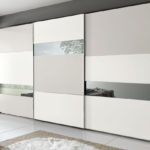Content
- 1 Transitional style essence
- 2 Soothing tones
- 3 Comfortable furniture
- 4 Accessories
Interior designers often face a dilemma.
For some people, the ultra-modern interior does not look very comfortable. Such styles are characterized by excessive directness and smoothness, which does not at all evoke a feeling of home comfort. However, if you focus only on the livability of the room without regard to style, the room will look like an old woman’s cloister. That is why you have to rack your brains in search of a "middle ground".
The answer to these pleas was the style of transition. It is the epitome of comfort with a touch of Art Nouveau. Below you can find out why this design is so attractive, and how you can translate it into a home. Simple tips will help once and for all to end the dispute between comfort and style.

Transitional style essence
The name of the style is translated from English as "transitional", and fully justifies itself. It is easy to guess that it appeared as a result of combining the features of opposing designs. Often it is also called the “updated version of the classics”, because it is at the junction of the best qualities of traditional and modern trends.

On the one hand, it provides the warmth, comfort and harmony inherent in traditional aesthetics. At the same time, the style of transition is not bogged down in patterned accessories, which sometimes give the traditional interiors the appearance of obsolescence. This style borrowed straight lines and simplicity from the contemporary style. Competently, such interiors give the impression of eternity with a modern bias.

Soothing tones
Two key parameters that you need to keep in mind when working with the style of transition are “simplicity” and “serenity”. Based on this, the goal of the designer in this case is to achieve an oasis effect in which you can hide from the hustle and bustle of everyday life. The first step along this path is to choose a soothing color palette. As usual, start with a neutral base, consisting of their muted tones.
You should give preference to soft gray and warm beige colors, setting aside later sharp black and deep brown shades. However, it is not forbidden to combine different tones. Fans of pastel colors can safely use them as both primary and secondary shades.

When introducing bright accents, you need to make sure that they do not violate the calm atmosphere of the interior. In this role, the blue gamut will perfectly show itself. It has been proven that these tones have a calming effect. Soft shades of green and purple also work well.

Comfortable furniture
In the style of transitional furniture really comes to the fore. Such furnishings differ in impressive dimensions and occupy a dominant position in the room. Ideally, furniture is the basis of design, and the surrounding space is built around it.

Finding furniture needs to focus on elements with simple shapes and straight lines that match the design of the contemporary. They should look quite airy and soft to create the illusion of hospitality and convenience.
The arrangement of furniture is also of considerable importance. Furnishings need to be grouped in one specific place in the room, leaving a considerable space around them. So the furniture will become the focal point. For example, in the living room you can concentrate the sofa and armchairs around the coffee table. In the study, chairs are placed at the desk. This arrangement of furniture is conducive to conversation and encourages lively communication.

Accessories
Because the design of the radiates neutrality and simplicity, accessories carry all the expressive load. They should be bright enough to cause visual interest, but not distract from the general mood of the room.

The best choice would be elements that increase comfort. You can actively use carpets, sofa cushions, rugs and blankets. Choosing decorative elements, it is recommended to strive to maintain the general theme of contemporary style.

-
 When an adjustable floor is more profitable than a capital screed
When an adjustable floor is more profitable than a capital screed
-
 What mistakes are made when the radiator is connected diagonally?
What mistakes are made when the radiator is connected diagonally?
-
 What are the consequences of building a site without permission?
What are the consequences of building a site without permission?
-
 What errors lead to water hammer in the heating system and how to avoid them
What errors lead to water hammer in the heating system and how to avoid them
-
 Why does the grinder work, but the disk does not spin
Why does the grinder work, but the disk does not spin
-
 What could cause the cabinet door to bend
What could cause the cabinet door to bend
-
 5 reasons to change the wizard without waiting for the repair to finish
5 reasons to change the wizard without waiting for the repair to finish
-
 How to cut tiles without dust
How to cut tiles without dust
-
 How to cut a fiberboard with a flat edge with a regular grinder
How to cut a fiberboard with a flat edge with a regular grinder
-
 Why you should not put aluminum radiators on central heating
Why you should not put aluminum radiators on central heating
-
 Why you can not allow for flaws in the installation of roof nodes from corrugated board
Why you can not allow for flaws in the installation of roof nodes from corrugated board
-
 What boards can not be used for half-timbered
What boards can not be used for half-timbered
New publications are published daily on our channel in Yandex. Zen
Go to Yandex. Zen


